
|
|
September 9, 2011
Citadel and CBS Radio, San Francisco
One of our favorite radio towns is, alas, one we don't get to as often as we'd like - San Francisco and the Bay Area. So when a family event drew us westward in January 2010, we jumped at the chance to add a couple of days to the agenda to do some catching up on sites (and radio friends) we'd been meaning to visit. By chance, our 2010 visit started at the exact same spot as our last significant radio trip to the Bay Area back in 2005: at the east end of the Dumbarton Bridge, at the magnificent three-tower site of KGO (810).
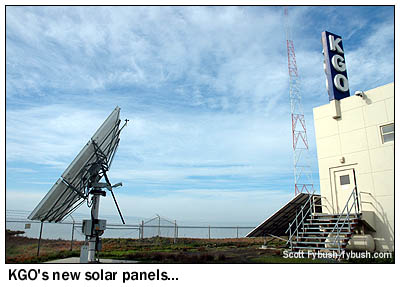 |
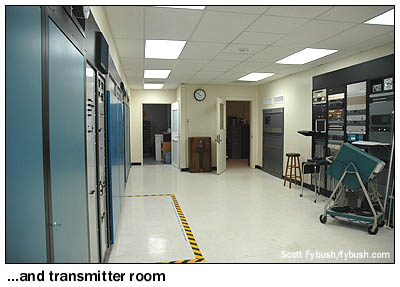 |
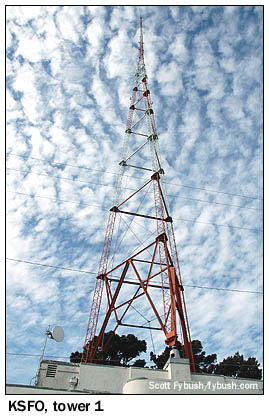
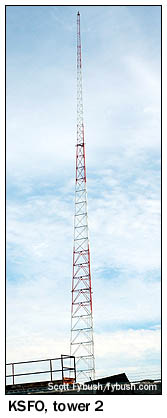 We featured this
site in
detail on Tower Site of the Week in late 2005, so we won't
recap the history or most of the specifics here this time - instead,
we'll point you to that 2005 segment for the history and instead
show you what we came to see this time: the new solar panels
adjacent to the transmitter building, providing a portion of
the electricity used to power KGO's 50,000-watt transmitter -
and one new transmitter, a Nautel XR50 (center right in the transmitter
room photo above) that has supplanted the two Nautel XLs at left.
We featured this
site in
detail on Tower Site of the Week in late 2005, so we won't
recap the history or most of the specifics here this time - instead,
we'll point you to that 2005 segment for the history and instead
show you what we came to see this time: the new solar panels
adjacent to the transmitter building, providing a portion of
the electricity used to power KGO's 50,000-watt transmitter -
and one new transmitter, a Nautel XR50 (center right in the transmitter
room photo above) that has supplanted the two Nautel XLs at left.
In addition to visiting transmitter engineer (and newly-minted Fellow of the Society of Broadcast Engineers) Art Lebermann at KGO, we also had a chance to take a spin past the other AM site he maintains for Citadel in San Francisco: the two-tower array of KSFO (560) along Islais Creek, on the edge of San Francisco Bay a couple of miles south of downtown San Francisco.
This is a fascinating site indeed: it dates back to 1937, when station owner Associated Broadcasters moved KSFO from Oakland (where it had been known as KTAB until 1935) across the bay to San Francisco, running 5000 watts by day and 1000 watts at night from a 389-foot Truscon tower mounted right atop the Art Deco transmitter building. More antennas sprouted at the Islais Creek site over the next few years as Associated added shortwave transmitters (using callsigns that included KWIX and KWID) to the facility. Shortwave went away in the 1950s, but a second AM moved in for a while, as competitor KFRC (610) diplexed from this tower until moving to the KRE site in Berkeley in 1968.
In 1981, KSFO boosted night power to 5000 watts by adding a second tower to the east of its existing tower - and there things have stood for three decades, through a series of formats (AC, oldies, talk) and a sequence of owners that culminated in 1995 with a sale that paired KSFO with KGO under ABC's ownership.
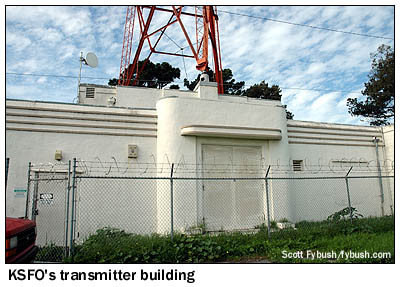
|
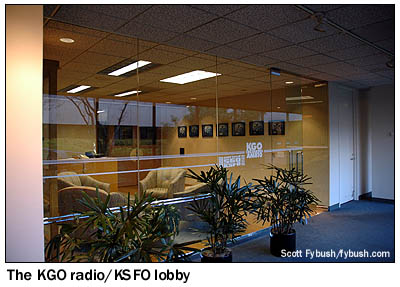 |
While KGO and KSFO have been sold several times since (ABC, Capital Cities, Disney, Citadel and soon Cumulus), they've remained paired - and at least until Cumulus takes over, they've been a two-AM cluster in a market that's increasingly full of much larger station groupings.
And for most of their time together, KSFO and KGO have remained in the same studio facility, occupying upstairs space in the ABC building at 900 Front Street. The radio stations are just tenants now, renting the space from Disney (which occupies most of the building itself with former sister station KGO-TV 7), but it's still a comfortable space, with newsroom and studios forming an "L" around one corner of the floor. The newsroom forms one end of the L, adjoining the KGO studios along the corner.
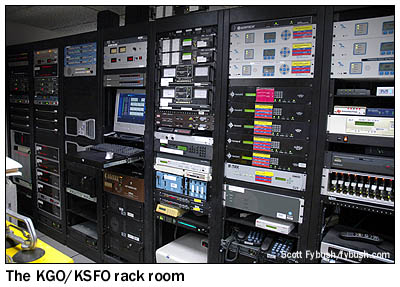 |
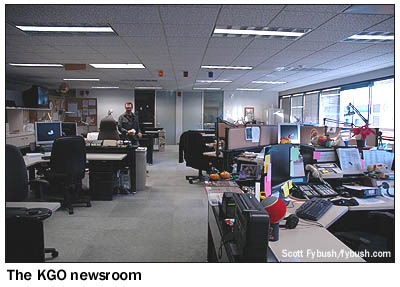 |
As one of the nation's most dominant talk stations, KGO has plenty of space for its talkers: a pair of mirror-image studios and control rooms accompanying a green-room space and production rooms.
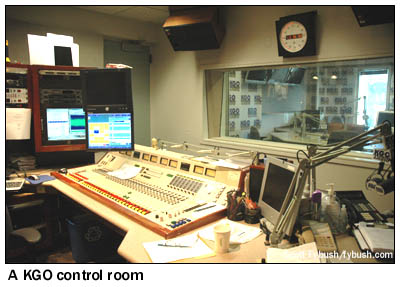 |
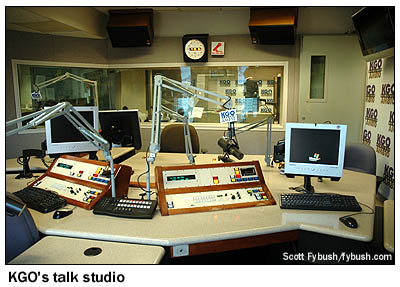 |
Around the far side of the "L" is a rack room for both stations and a smaller studio/control room pair for KSFO, which runs mostly syndicated talk these days after building an early reputation as one of the first "hot talk" stations.
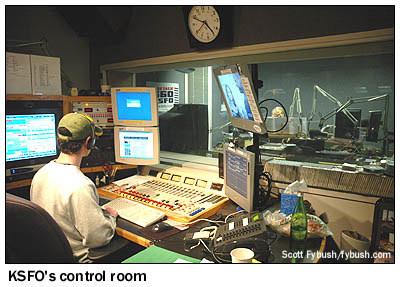 |
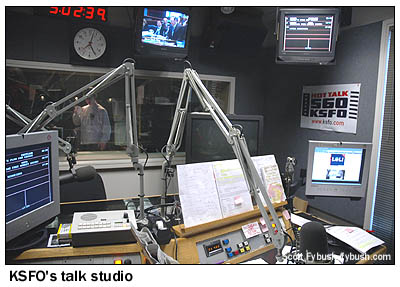 |
Up on the roof, most of those dishes belong to KGO-TV, but the radio stations have a few of their own, as well as STL dishes aimed south toward Islais Creek for KSFO and Newark for KGO.
And after leaving KGO on this balmy San Francisco Saturday afternoon, we detour a few blocks away to check out a surviving bit of KGO's legacy. As we'd mentioned in our KNBR installment a few weeks ago, there was a time when today's KNBR (then KPO) and KGO were sister stations, with KPO (the NBC Red Network outlet) owned by NBC itself and KGO (owned by founder General Electric) being operated by NBC as the Blue Network signal. From 1942 until the early 1950s, KPO and KGO shared that building shown below at right: NBC's "Radio City" at 420 Taylor Street, a massive complex of studios, offices and a parking garage that were largely obsolete the day they opened. The building has recently been renovated, and thankfully the Art Deco tiled mural above the main entrance, as well as the lobby itself, have been preserved. (And we'll again point you to Fred Krock's magnificent tribute to 420 Taylor Street, at Barry Mishkind's Oldradio site, to learn more...)
Remarkably, just one studio facility separated 420 Taylor Street in 1942 from 900 Front Street today: after ABC split from NBC, KGO stuck around Taylor Street as a tenant until 1954, when it relocated to 277 Golden Gate Avenue, where it remained until the move to Front Street in the 1980s.
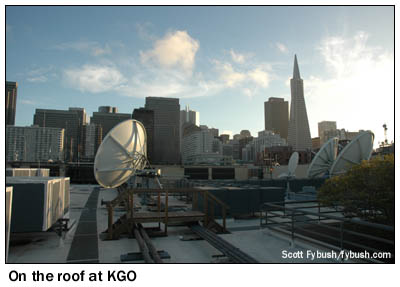 |
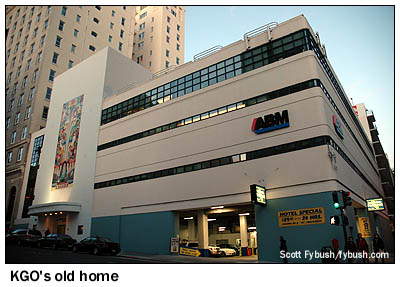 |
So we've dealt with the former NBC and ABC flagship radio stations in San Francisco: what about CBS?
The tangled web that ends at 855 Battery Street, a block west of KGO, included many decades when CBS owned radio stations in San Francisco but did not own its TV affiliate - and the reasons for that are intricately tied up with, of all things, KSFO. In the 1940s, KSFO (which had been a CBS affiliate until the network bought KQW in San Jose) held a construction permit to move from 560 to 740, boosting power to 50,000 watts from a new site north of San Francisco.
But TV was coming into the picture, too, and by the time KSFO was ready to start building out its new AM signal after World War II, Associated Broadcasters was focusing on the TV construction permit that would become KPIX, channel 5. But it needed an affiliation, and that's where CBS and KQW came into the picture: instead of moving KQW from 1010 on the dial (a relatively weak San Jose-based signal at the time) to 560, CBS was able to move KQW to the 50,000-watt 740 facility...in exchange for granting the CBS-TV affiliation to KPIX.
And thus it was that KQW became KCBS on 740 from a new transmitter plant way up north in Novato, while KSFO remained on 560, eventually selling KPIX-TV to Westinghouse Broadcasting, which continued to operate it as a CBS affiliate right up until Westinghouse acquired CBS in its entirety in 1995...thus, at long last, putting KCBS and KPIX-TV under common CBS ownership.
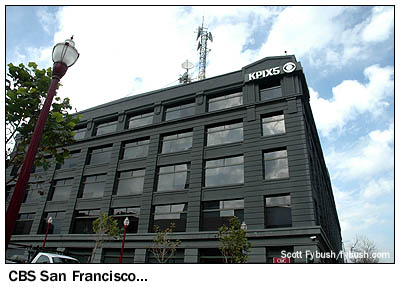 |
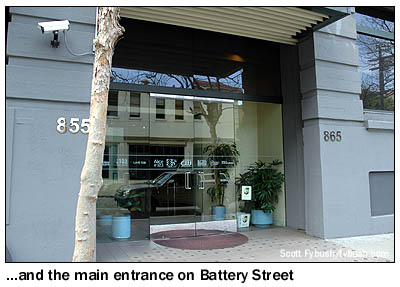 |
It took a few more years for KCBS to end up under the same physical roof as KPIX: at the time, Westinghouse had itself been dabbling in radio ownership, buying classical KKHI (1550) and KKHI-FM (95.7) and flipping them to news-talk as KPIX/KPIX-FM from a newsroom adjacent to the KPIX-TV studio. KCBS and sister station KLLC (Alice 97.3) had been in studios on a high floor of the One Embarcadero Center skyscraper a few blocks to the south, but once that lease was up, they came over to the KPIX-TV building at 855-865 Battery Street, where they became part of a larger cluster that came together over the years out of pieces of CBS, Infinity and Westinghouse's legacy groups.
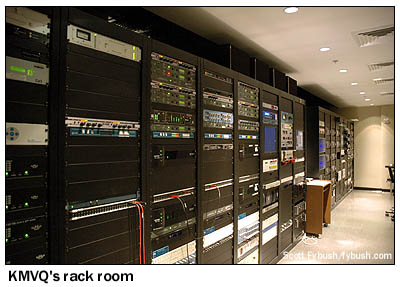 |
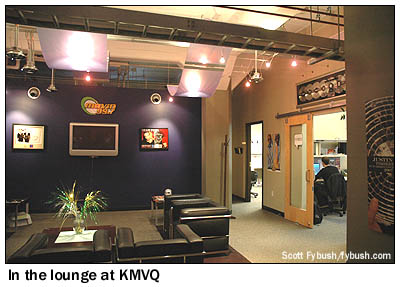 |
Today, CBS Radio in San Francisco includes four FMs (KLLC 97.3, KMVQ 99.7, KITS 105.3 and KFRC-FM 106.9) and two AMs (KCBS 740 and KZDG 1550), and they're spread out among several studio/office clusters within the 855-865 Battery Street building. KMVQ (which was just beginning its transition from rhythmic AC "Movin" to top-40 "Now" when we visited in 2010) occupied the newest cluster of studios on the south side of the building, in a space that had been designed for another FM as well. When CBS traded KFRC 610 to Family Stations for the former KEAR-FM 106.9 in 2005, the FM station (initially talk "Free FM" KIFR) was over here, and it remained here as classic hits KFRC-FM from 2007 until October 2008, when it began simulcasting the all-news format of KCBS.
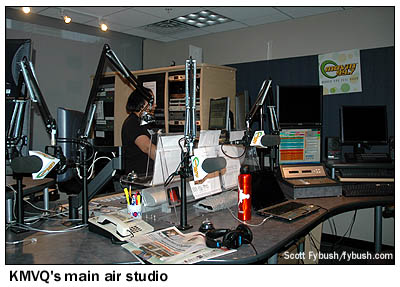 |
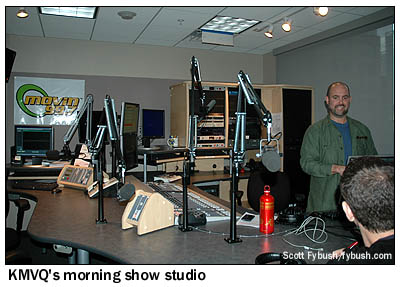 |
The studio space on this side of the building was also home to 1550 AM, the last remaining vestige of Westinghouse's San Francisco radio venture. (The former KPIX-FM 95.7 was sold off to Bonneville, and it's now in Entercom's hands as sports-talk KGMZ.) As for the AM, it muddled through a succession of low- or no-rated formats, including all-podcast "KYou Radio" and True Oldies Channel automation, before going to leased-time South Asian programming as "Radio Zindagi" this fall. At the time of our visit in January 2010, there was one "True Oldies Channel KFRC 1550" banner to be seen in the halls over here, next to a studio where live programming could run on 1550 during sporting events, including the Oakland A's games that originated here for a time.
One more quick bit of irony before we move on: what's now KMVQ on 99.7 is one of the oldest FM stations in San Francisco, having started out back in the 1940s as...yup, KNBC-FM, owned by NBC with studios in the 420 Taylor Street "Radio City" building. (It went to Emmis when NBC spun off its radio stations in the late 1980s, then eventually to Infinity before merging into CBS.)
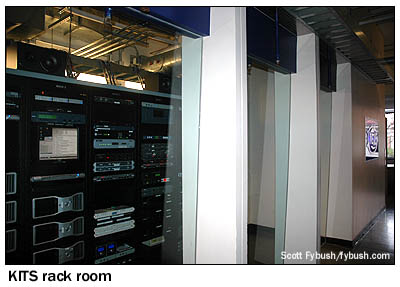 |
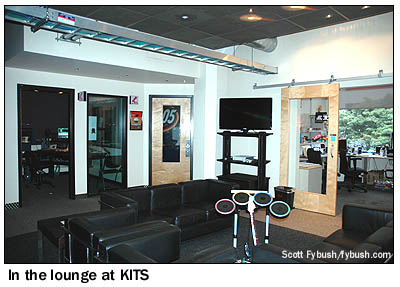 |
The rest of the cluster is over on the north side of the building: KITS ("Live 105") has its own pod of studios and offices, including a rack room with nifty full-length windows facing the hallway and a lounge area outside its production and air studios.
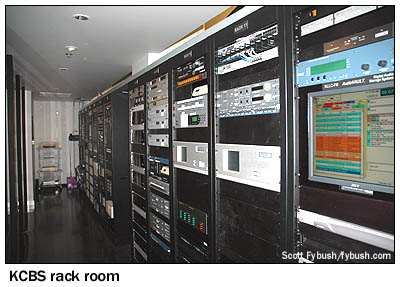 |
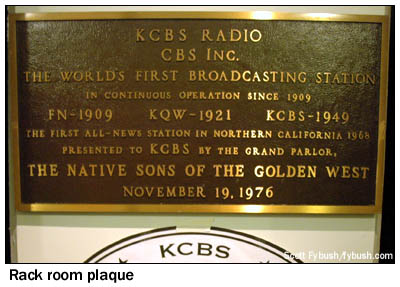 |
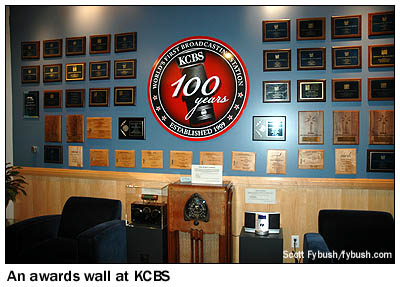 |
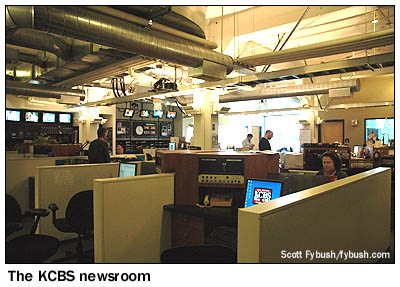 |
But we came, really, to see KCBS itself, and we find it along the north wall of the building, where a winding hallway leads from the KCBS/KLLC lobby past a wall of awards and history and past a rack room to the spacious, industrial-chic newsroom. A word about that rack room: it's the only one we've ever seen with a historical society plaque on the wall, honoring the legacy that traces back from today's KCBS to its San Jose predecessor KQW to the legendary Charles "Doc" Herrold, who began broadcasting from San Jose way back in 1909.
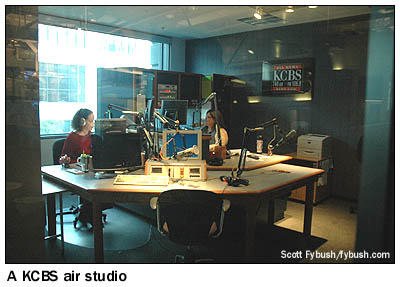 |
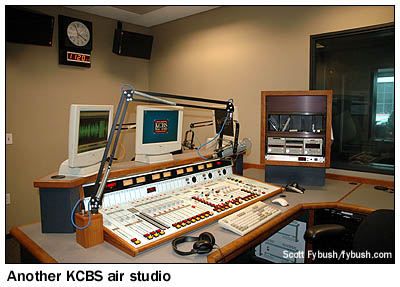 |
Today's KCBS, while honoring its century-plus of history, is a showplace of all-digital all-news radio, with all that energy from the newsroom channeling into a trio of studios at one side, where teams of newscasters alternate from studio to studio as they move through the hour and the day.
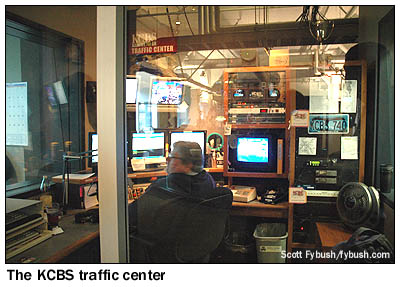 |
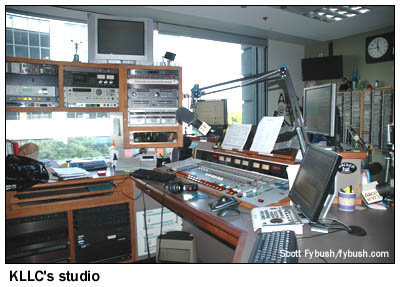 |
KCBS does its own traffic, and the compact traffic center is adjacent to one of the news studios. And down the hall is KLLC, the original FM sister to KCBS (albeit with several call changes and one frequency move along the way from the original KCBS-FM on 98.9.) The studio here is a nearly identical copy of the KITS ("Live 105") studio, not shown here.
There's still one more installment of our San Francisco trip yet to go - join us again right here next week for a visit to the FM and TV transmitters at Mount Sutro and Mount San Bruno, and check in as well over at Tophour.com to hear lots and lots of San Francisco legal IDs!

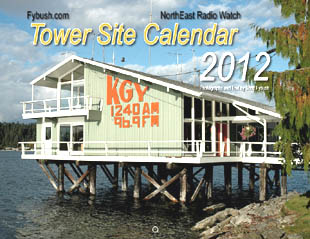 - Find out when the new Tower Site is posted,
and much more! Follow us on Twitter @NERadioWatch - and don't miss your very first chance to
order the new Tower Site Calendar 2012, now available at the
Fybush.com
store!
- Find out when the new Tower Site is posted,
and much more! Follow us on Twitter @NERadioWatch - and don't miss your very first chance to
order the new Tower Site Calendar 2012, now available at the
Fybush.com
store!- Previous Site of the Week: San Francisco, CA, 2010 (part II)
- Next Week: San Francisco, CA, 2010 (part IV)
- Site of the Week INDEX!
- How can you help support Site of the Week? Click here!
- Submit your suggestions for a future Site of the Week!
